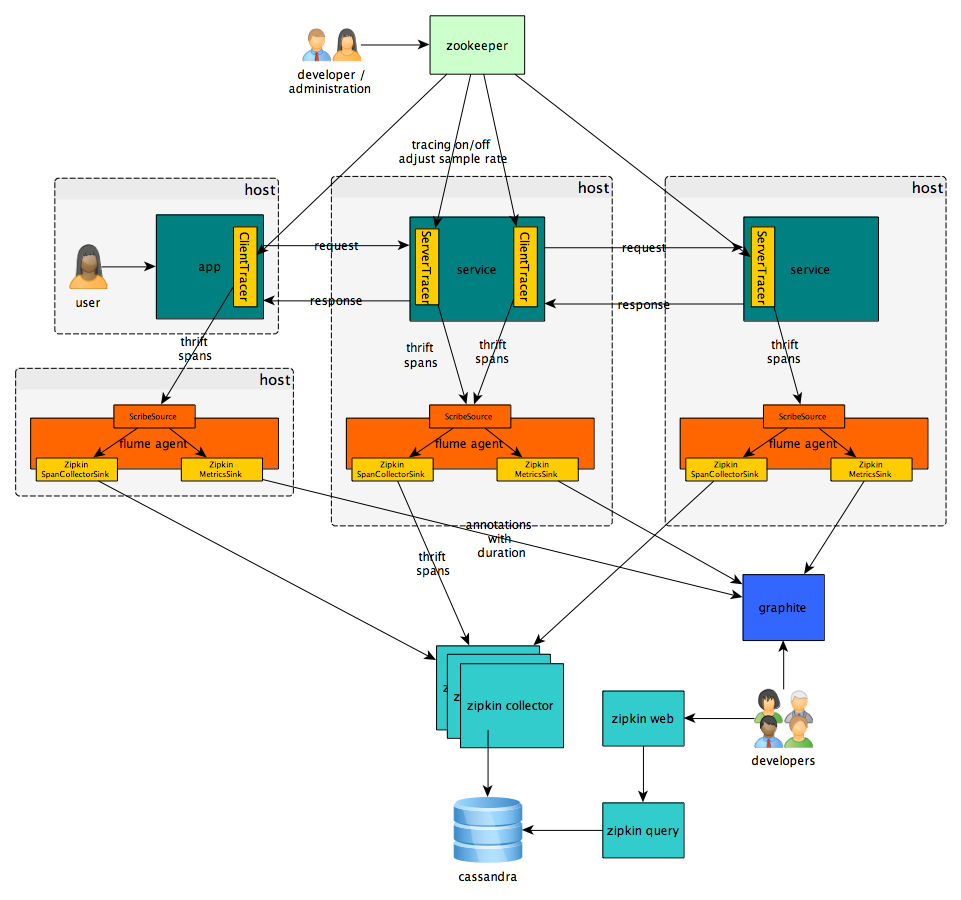Java implementation of Dapper and inspired by Zipkin.
dapper (dutch) = brave (english)... so that's where the name comes from.
I advise you to read the Dapper paper, but in short:
What we want to achieve is understand system behavior and performance of complex distributed systems. We want to do this with minimal impact on existing code by introducing some small common libraries that are reusable and don't interfere with the existing business logic or architecture. Besides not impacting business logic or architecute we off course also want it to have a neglectable impact on performance.
I looked into reusing zipkin 'as is' but did not find an elegant way to use the exising Scala code/api's into the Java/Spring code I want to incorporate it. I'm however very thankful to Twitter for open sourcing Zipkin! Is is by seeing their Zipkin video and presentation that I got to know Zipkin/Dapper and that I saw the potential and the simplicity of the solution.
As you can read later, brave can be integrated in Zipkin so that the cassandra back-end store and web ui are reusable.
- span: A single client/server request/response. Can have an optional parent span id and is part of a trace.
- trace: A tree of spans.
So as you can see a single span is submitted twice:
- from the client side, the initiator, with cs (client send) and cr (client received) annotations
- from the server side with sr (server received) and ss (server send) annotations.
The above image shows how Brave integrates with Zipkin. This is an option but not required. You can create new SpanCollector implementations that submit Span/Trace data to other data stores or processing engines.
All api access is centralized in com.github.kristofa.brave.Brave
This class contains only static methods. Reason is that the returned components should share the same span state which is maintained as a singleton in com.github.kristofa.brave.Brave.
public static EndPointSubmitter getEndPointSubmitter()
Each annotation that is being submitted (including cs, cr, sr, ss) has an endpoint (host, port, service name) assigned. For a given service/application instance the endpoint only needs to be set once and will be reused for all submitted annotations.
The EndPoint needs to be set using the EndPointSubmitter before any annotation/span is created.
In the brave-resteasy-spring module the EndPoint is set in com.github.kristofa.brave.resteasy.BravePreProcessInterceptor.
public static ClientTracer getClientTracer(final SpanCollector collector, final TraceFilter traceFilter)
Get a ClientTracer that will be initialized with a specific SpanCollector and a custom TraceFilter.
The ClientTracer is used to initiate a new span when doing a request to another service. It will generate the cs (client send) and cr (client received) annotations. When the cr annotation is set the span will be submitted to SpanCollector if not filtered by TraceFilter.
public static ServerTracer getServerTracer(final SpanCollector collector)
Get a ServerTracer that will be initialized with a specific SpanCollector. The ServerTracer and ClientTracer should share the same SpanCollector.
The ServerTracer will generate sr (server received) and ss (server send) annotations. When ss annotation is set the span will be submitted to SpanCollector if our span needs to get traced (as decided by ClientTracer).
The ServerTracer sets the span state for an incoming request. You can see how it is used in the brave-resteasy-spring module in the com.github.kristofa.brave.resteasy.BravePreProcessInterceptor and the com.github.kristofa.brave.resteasy.BravePostProcessInterceptor
public static SpanCollector getLoggingSpanCollector
Returns a SpanCollector that will log the collected span through sl4j. Can be used during testing or debugging.
public static TraceFilter getTraceAllTraceFilter()
Returns a TraceFilter that will trace all requests. To be used when debugging or during development.
public static AnnotationSubmitter getServerSpanAnnotationSubmitter()
The AnnotationSubmitter is used to submit application specific annotations.
public static ServerSpanThreadBinder getServerSpanThreadBinder()
To be used in case you execute logic in new threads within you service and if you submit annotations or new requests from those threads. The span state is bound to the request thread. When you start new threads it means that the span state that was set in the request thread is not available in those new threads. The ServerSpanThreadBinder allows you to bind the original span state to the new thread.
The brave-resteasy-example is a good starting point to get you up to speed on how you can implement brave in your own apps.
The brave-resteasy-spring module has RESTEasy pre- and postprocess interceptor implementations that use the ServerTracer to set up the span state.
There is a separate example application that shown how to set up and configure the RESTEAsy integration using Spring -> https://github.com/kristofa/brave-resteasy-example
brave-resteasy-spring puts the Spring and RESTEasy dependencies to scope provided which means you have to add the dependencies to your own application. Important to know is that you should use a recent RESTEasy version otherwise the integration might not work. It does for example not work with RESTEasy 2.2.1.GA. It does work with 2.3.5.Final which is also used in brave-resteasy-example. When it comes to Spring the oldest version I tried out and which worked was 3.0.5.
There is a ZipkinSpanCollector which converts the Brave spans to Zipkin flavour and submits them to the Zipkin SpanCollector. See https://github.com/kristofa/brave-zipkin-spancollector.
Version 1.0 is available in Maven central. So you can simple add the dependencies you need to your pom.xml:
<dependency>
<groupId>com.github.kristofa</groupId>
<artifactId>brave-interfaces</artifactId>
<version>1.0</version>
</dependency>
<dependency>
<groupId>com.github.kristofa</groupId>
<artifactId>brave-impl</artifactId>
<version>1.0</version>
</dependency>
<dependency>
<groupId>com.github.kristofa</groupId>
<artifactId>brave-resteasy-spring</artifactId>
<version>1.0</version>
</dependency>
- Binary annotation support (key=value). Is not supported in 1.0
- Add Flume support which can route the spans to the components that do the actual persistence. Flume would replace the role of Scribe that is used in Zipkin.
- Zookeeper support to enable/disable tracing and update sample rate globally for all services.
